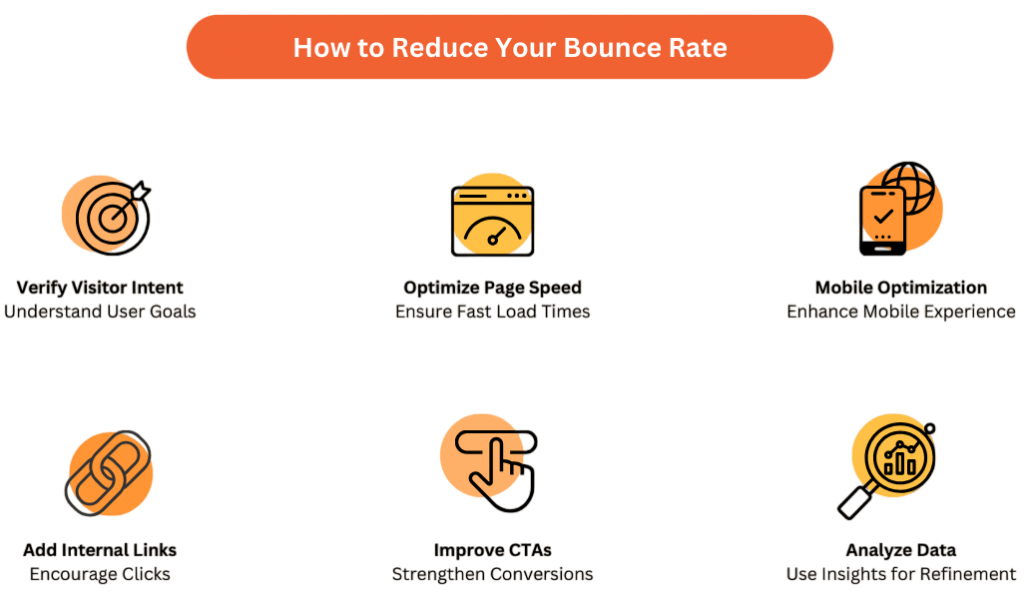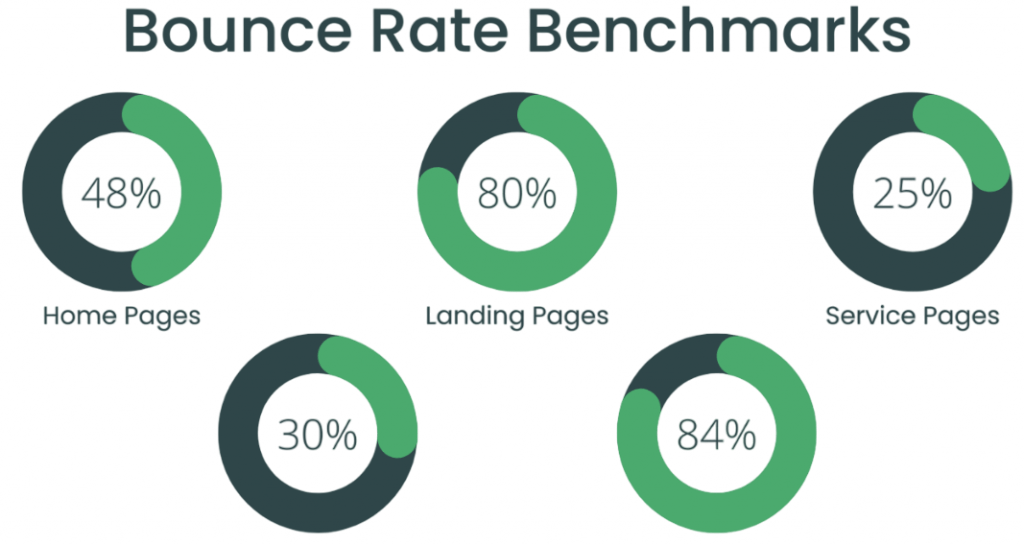
- What Is Bounce Rate
- Why Bounce Rate Matters
- What’s a “Normal” Bounce Rate
- What Drives High Bounce Rates
- How to Measure and Interpret Bounce Rate
- Strategies to Reduce Bounce Rate
- Monitoring and Ongoing Optimization
- When a Bounce Isn’t Bad
- Bounce Rate vs. Related Metrics
- Real-World Examples
- Conclusion
What Is Bounce Rate?
Bounce rate is the percentage of visitors who land on a website and leave without interacting further or visiting any other pages. It’s a critical metric in digital marketing because it reflects the first impression and relevance of a webpage to its audience. In Google Analytics 4 (GA4), bounce rate is defined as the percentage of sessions that were not considered engaged a redefined metric explored in Digital Marketing Training, where learners interpret GA4 engagement signals, configure session parameters, and optimize landing pages to reduce bounce rates and improve user retention. An engaged session typically includes staying on the site for at least 10 seconds, viewing more than one page, or triggering a conversion event. Understanding bounce rate helps digital marketers determine whether users are finding what they expect when they click on a link or ad.
Ready to Get Certified in Digital Marketing? Explore the Program Now Digital Marketing Online Training Offered By ACTE Right Now!
Why Bounce Rate Matters
Understanding bounce rate is important for digital marketers who want to improve website performance and user engagement. A high bounce rate often points to issues with content relevance, responsive design, or user experience. It shows that visitors do not find the information or interaction they expect.When users leave a webpage quickly, it suggests potential problems like misaligned content, an unattractive layout, or technical issues that do not meet their needs behavioral signals that influence metrics like What is Alexa Ranking, a system that evaluates website popularity based on traffic volume and engagement. High bounce rates can negatively impact your Alexa Rank, signaling poor user experience and prompting SEO adjustments to improve retention and relevance. Bounce rate is more than just a website statistic it is a key measure that affects conversion chances and search engine performance. Generally, lower bounce rates relate to higher user engagement, which directly affects business goals such as form submissions, product purchases, and sign-ups. Although bounce rate is not a direct ranking factor, it gives valuable insights into user behavior. It can also indirectly influence organic search rankings by indicating the quality of user experience to search engines. By examining bounce rate closely, digital marketers can find and fix potential barriers that keep users from engaging meaningfully, ultimately enhancing website effectiveness and reaching marketing goals.
What’s a “Normal” Bounce Rate?
- Bounce rates differ widely across industries. E-commerce websites have the lowest rates, ranging from 20 to 45%. In contrast, blogs and content sites face the highest rates, between 65 and 90%. This difference shows how important it is to understand user engagement patterns unique to each industry.
- The type of device also significantly affects bounce rates. Mobile traffic has the highest bounce rate, between 50 and 60%. This is due to smaller screens, slower connections, and less user patiencefactors that directly impact Digital Marketing Components, where mobile UX optimization plays a critical role in campaign success. Responsive design, fast-loading pages, and simplified navigation are essential to meet user expectations and reduce bounce rates.
- Traffic sources also greatly influence bounce rates. Social media and display ads generate the highest bounce rates, at 54% and 56%, because they often attract users with lower intent. On the other hand, email campaigns have the lowest bounce rate, around 35%.
- SaaS/B2B websites and the education/nonprofit sectors show relatively consistent bounce rates between 35 and 60%. This consistency suggests these industries attract more engaged and purposeful visitors compared to content-heavy or impulse-driven sectors.
- Slow Page Speed: Users expect pages to load within two seconds. A delay of even a second can significantly increase bounce rates. Page speed is a key factor in user satisfaction and retention.
- Poor Mobile Optimization: With a large percentage of web traffic coming from mobile devices, a non-responsive or poorly optimized mobile site often leads to immediate exits.
- Mismatched Search or Ad Intent: If users click on a link expecting one thing but find something different, they’ll likely leave without exploring further. This mismatch often results from poorly aligned keywords, meta descriptions, or ad copy.
- Low-Quality or Irrelevant Content: Thin content, misleading headlines, or outdated information can make users feel like they’ve wasted their time. They won’t stay to see what else the site offers.
- Distracting Design or Popups: Sites with excessive popups, autoplay videos, or confusing navigation tend to push users away rather than inviting them to explore.
- Track bounce rate changes after making site updates.
- Analyze performance monthly or quarterly.
- Compare bounce rate to other engagement metrics like session duration and pages per session..
- Stay updated with Google’s algorithm and UX best practices
- A visitor reads a blog post and leaves satisfied.
- A user gets contact information and calls directly.
- A landing page delivers a downloadable resource instantly.
- Exit Rate: The percentage of people who leave from a specific page, regardless of how many pages they viewed before.
- Time on Page: Average duration a user spends on a page. Useful for gauging engagement.
- Pages per Session: Higher numbers often suggest better user flow and engagement.
- Engaged Sessions (GA4): Tracks meaningful interactions more accurately than traditional bounce rate.
- Example 1: E-commerce Store: A fashion brand noticed a 72% bounce rate on mobile. After implementing responsive design and improving page load times, bounce rate dropped to 45%, and average time on site doubled.
- Example 2: B2B SaaS Company: A landing page had a bounce rate of 68%. After updating the copy to better match ad messaging and adding customer testimonials, the bounce rate fell to 38%, and lead form submissions increased by 60%.
- Example 3: Content Blog: A personal finance blog had a bounce rate of 89%. By breaking up long paragraphs, adding related articles, and using better meta descriptions, bounce rate decreased to 65% and average session duration increased by 40 seconds.
To Explore Digital Marketing in Depth, Check Out Our Comprehensive Digital Marketing Online Training To Gain Insights From Our Experts!
What Drives High Bounce Rates?
How to Measure and Interpret Bounce Rate
In digital analytics, businesses use tools like Google Analytics 4 (GA4), Hotjar, and Microsoft Clarity to gain insights into user behavior and website performance. By applying different segmentation strategies across devices, channels, and landing pages, they discover important patterns in user engagement analytical techniques refined through Digital Marketing Training, where learners master audience segmentation, cross-platform behavior analysis, and data-driven personalization to optimize campaign performance and user experience. Looking at metrics such as mobile and desktop bounce rates, the quality of traffic from paid ads, and how well specific landing pages perform helps organizations identify areas that need improvement. This data-driven method shows where users may struggle during their journey and helps teams focus on key improvements that improve the overall digital experience and boost conversion rates.
Looking to Digital Marketing Training? Discover the Digital Marketing Expert Masters Program Training Course Available at ACTE Now!
Strategies to Reduce Bounce Rate
To improve website performance and user experience, businesses need to adopt a clear digital strategy that covers several important areas. They can boost site speed by compressing images, using a content delivery network (CDN), removing render-blocking JavaScript, and reducing HTTP requests technical optimizations increasingly vital in Social Media Has Changed the Music Festival, where digital-first festivals rely on fast-loading websites to handle ticketing surges, livestream traffic, and influencer-driven engagement. Performance tuning ensures seamless user experience while amplifying reach across social platforms. Mobile optimization is also essential. Businesses should implement responsive design, ensure tap targets are the right size, and create mobile-friendly forms and calls-to-action.

To connect content with user intent, they need to align headlines with search results, focus on relevant keywords, and communicate clear, straightforward messages that directly address user needs. Improving content quality through careful structuring using subheadings, white space, multimedia elements, and internal links helps keep users engaged. Businesses must manage popups and advertisements carefully, prioritizing non-intrusive placement to improve user experience. They can strengthen calls-to-action by using clear, actionable language and thoughtful positioning, which can greatly increase conversion rates. Lastly, they should conduct systematic A/B testing on various elements like headlines, layouts, and CTA designs. This approach allows for evidence-based adjustments that continuously enhance website performance and user interaction.
Monitoring and Ongoing Optimization
Reducing bounce rate is not a one-time fix. Ongoing monitoring and improvement are essential an iterative mindset central to What is Agile Marketing, where marketers adopt data-driven experimentation, rapid feedback loops, and continuous optimization to enhance user engagement, refine messaging, and improve campaign performance across evolving digital touchpoints.
Preparing for Digital Marketing Job Interviews? Have a Look at Our Blog on Digital Marketing Interview Questions and Answers To Ace Your Interview!
When a Bounce Isn’t Bad
There are cases where a bounce doesn’t signal a problem: for example, when users find exactly what they need on a single page like a contact number, address, or quick answer and leave satisfied. These context-driven behaviors are important in SEO vs SEM, where SEO focuses on long-term organic engagement and SEM delivers immediate visibility through paid ads. Understanding bounce rate nuances helps marketers interpret performance metrics more accurately across both strategies.

In such cases, the user’s intent is fulfilled, even though no further clicks occur.
Bounce Rate vs. Related Metrics
Related metrics should be used together to get a full picture of performance.
Real-World Examples
Conclusion
Bounce rate provides important insights and acts as a key metric in online marketing. It serves as an alert system that points out problems with user interest and highlights areas that need improvement. When users leave your site quickly, this metric reveals the issue an engagement signal decoded in Digital Marketing Training, where learners interpret bounce rate behavior, troubleshoot user drop-offs, and optimize site experience to improve retention and conversion outcomes. A high bounce rate shows that visitors are not finding what they expect. The content may lack relevance, the site could be difficult to navigate, or it might have a slow loading time. These issues frustrate visitors and lead them to leave without interacting further. By understanding why users bounce, you can tackle these problems and greatly improve the user experience. Happy visitors stay longer, explore more pages, and are more likely to take desired actions, which increases your conversions. This translates to more sales or leads. Reducing bounce rate has a direct impact on your bottom line and enhances the success of your online marketing efforts.




